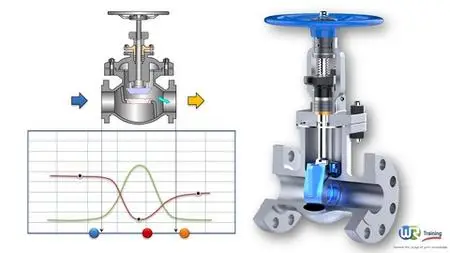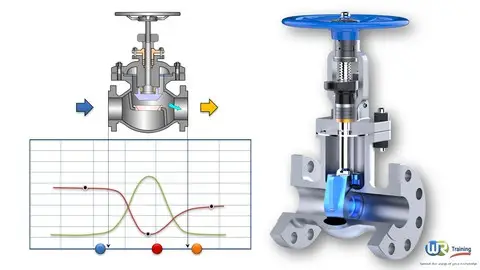Sizing Valves And Control Valves For The Process Industry
Last updated 11/2022
MP4 | Video: h264, 1280x720 | Audio: AAC, 44.1 KHz
Language: English | Size: 1.05 GB | Duration: 2h 13m
Last updated 11/2022
MP4 | Video: h264, 1280x720 | Audio: AAC, 44.1 KHz
Language: English | Size: 1.05 GB | Duration: 2h 13m
A complete understanding of the valve sizing procedure for any flow conditions likely to be found in a process plant
What you'll learn
Be more innovative in your solutions to valve and control valve problems
Have an organized approach to the procedure of valve sizing in accordance with the ANSI & ISA recommendations
Be able to size valves for any flow conditions likely to be found in a process plant
Have a general notion about the confidence to be placed in the sizing result conclusions
Download our valuable Valve Sizing Excel Spreadsheet
Requirements
The student who will gain the most from this course will come equipped with some knowledge of fluid systems and an acquaintance with process valves. For these reasons, we strongly recommend that prior to taking the present course, you attend first our courses :
1. Valves : Principles, Operation & Design
2. Flow of fluids through piping systems, fittings, valves and pumps
3. Designing piping systems : Pipe, fittings, flanges and valves
Please note that the mathematics in this course is undemanding. All the work can be done with a hand-held calculator with powers, roots and log functions.
To further help you in this task, the course is accompanied with a Valve Sizing Spreadsheet. The Valve sizing spreadsheet will help you perform all the calculations that we will discuss further ahead in the course. It has all the sizing equations, numerical constants and other parameters built right into it.
We assume that Microsoft Excel is installed on your computer and that you have basic knowledge of using Excel.
Description
––––––––––––––––––––-MAJOR COURSE UPDATE:We have added a quiz at the end of each section to help you test your knowledge and emphasize the key learning points. The quiz includes:True/False questionsMulti-choice questionsImages, cross-sectionnal viewsSolved problemsand much more…When you think you’ve got a good grasp on a topic within the course, you can test your knowledge by taking the quiz. If you pass, wonderful ! If not, you can review the videos and notes again or ask us for help in the Q&A section.––––––––––––––––––––-Designed around a series of practical examples which we work through to a solution, this valuable online course is an essential guide to understanding the valve sizing procedure. This understanding is a prerequisite for a successful operation of your plant and piping system.In this course, we will present a step-by-step sizing methodology. We will show you how to proceed in the sizing of a valve in the daily practice, how to determine the flow coefficient (Cv) when selecting a control valve size, how to predict the maximum flow rate that a selected valve will pass or how to determine the pressure differential that a selected valve will exhibit, just to name a few…You will learn from our industrial experience what we wrongly calculated during project startup, debottlenecking and commissioning. This should undoubtedly help you minimize the mistakes in the sizing and selection of your valves.Included in this course is access to a valuable Valve Sizing Excel Spreadsheet. This tool will help you perform all the calculations that we will discuss further ahead in the course. It has all the sizing equations, numerical constants and other parameters built right in.The Valve Sizing Excel Spreadsheet provides well organized technical data in form of spreadsheet calculations indispensible for anyone involved in the sizing of valves. It presents formulae and data for :Valve flow coefficients CvFlow of fluids through valvesPressure drop through valves and attached fittingsValve Reynolds Number calculationsPredicting maximum flow through valves in choked conditionsRepresentative values of valve capacity factorsAnd much more…The spreadsheet includes two worksheets :Sizing for liquids (incompressible fluids)Non vaporizing flow conditionsChoked flow conditionsSizing for vapors and gases (compressible fluids)So as you can see here, detailed technical descriptions and basic step-by-step instructions will be provided to you along with practice sessions, quizzes, a valuable Valve Sizing Spreadsheet and numerous downloadable resources, to emphasize the key learning points.So with no further ado, check out the free preview videos and the curriculum of the course and we look forward to seeing you in the first section.WR TrainingSpread the wings of your knowledge–––––––––––––––IMPORTANT NOTES : VALVE SIZING SPREADSHEETWe assume that Microsoft Excel is installed on your computer and that you have basic knowledge of using ExcelThis Valve Sizing Excel Spreadsheet includes Visual Basic for Application function subroutines (VBA). Macros must be enabled for them to workDISCLAIMERThe Valve Sizing Excel Spreadsheet is provided by WR Training "as is" and any express or implied warranties, including, but not limited to, the implied warranties of merchantability and fitness for a particular purpose are disclaimed. In no event shall the Copyright owner or contributors be liable for any direct, indirect, incidental, special, exemplary, or consequential damages (including, but not limited to, procurement of substitute goods or services, loss of use, data, or profits, or business interruption) however caused and on any theory of liability, whether in contract, strict liability, or tort (including negligence or otherwise) arising in any way out of the use of this spreadsheet, even if advised of the possibility of such damage.
Overview
Section 1: About the course
Lecture 1 Introduction
Lecture 2 Before to start this course
Lecture 3 Valve Sizing Spreadsheet
Section 2: Preliminaries
Lecture 4 Scope
Lecture 5 Introduction
Lecture 6 Useful terminology
Lecture 7 Pressure, Velocity and Energy profiles through valves
Lecture 8 Cavitation, Choked Flow and Flashing
Lecture 9 Before proceeding to the next section
Section 3: Incompressible fluids
Lecture 10 Non vaporizing liquids
Lecture 11 Sizing equations for turbulent flow
Lecture 12 Piping geometry factor Fp
Lecture 13 EXAMPLE #1 : Sizing a valve for liquid propane
Lecture 14 Sizing equations for non turbulent flow
Lecture 15 More insights on non turbulent flow
Lecture 16 Determining the required flow coefficient Cv
Lecture 17 EXAMPLE #2 : Sizing a valve for a laminar flow
Lecture 18 Predicting flow rate through valves
Lecture 19 EXAMPLE #3 : Predicting flow rate through a valve for transient flow
Lecture 20 Predicting pressure drop through valves
Lecture 21 EXAMPLE #4 : Predicting pressure drop for laminar flow
Lecture 22 Choked flow of vaporizing liquids
Lecture 23 Liquid critical pressure ratio factor FF
Lecture 24 Liquid pressure recovery factor FL (without fittings)
Lecture 25 Combined liquid pressure recovery factor FLP (with fittings)
Lecture 26 EXAMPLE #5 : Predicting maximum flow through a valve
Lecture 27 Before proceeding to the next section
Section 4: Compressible fluids
Lecture 28 Turbulent flow
Lecture 29 Expansion factor
Lecture 30 Choked flow
Lecture 31 Pressure drop ratio factor (without fittings)
Lecture 32 Pressure drop ratio factor (with fittings)
Lecture 33 Ratio of specific heats factor
Lecture 34 Compressibility factor
Lecture 35 EXAMPLE #6 : Determining valve size and percent opening
Lecture 36 Before proceeding to the next section
Section 5: Downloadable resources
Lecture 37 Included in this course
Lecture 38 Bonus
Chemical, Process, Petroleum Engineers,Design Engineers,Piping Engineers,Plant Engineers,Recent College Graduates



